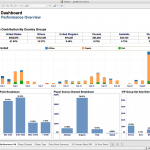Redefining The Importance Of Data Through Storytelling
When people think of storytelling, they don’t often think of data. Most often, people associate stories with the recounting of previous events or the foretelling of things to come. However, storytelling is an important aspect that should be considered when presenting data. Without a story, data becomes numbers on a page or analytics that are hard to define or apply to the real world.
Why Is Storytelling So Important To Presenting Data?
Did you know that the statistics surrounding data findings can often be confusing? Did you also know that it is easy to misunderstand the links between the cause and effects of different data findings? These two challenges are the top reasons that storytelling needs to be leveraged when data is presented.
Through storytelling, the data’s story can be properly told so that it can be used to implement business improvements. Like any tale of heroes and damsels in distress, a story surrounding data
findings needs to both educate and entertain. Your audience should be swept into the narrative journey and held captive from beginning to end. In this vein, you should begin your story by telling about the problem that needs to be solved. Next, you need to keep the audience’s attention as you tell the middle of the story, and eventually end with the outcome or solution to the problem.
While every storyteller has his or her own style, the following steps will help you to craft the story needed to successfully present your data:
- Acknowledge the performance or problem that your data identifies.
- Analyze the impact of the performance or problem.
- Determine and show how the analysis from step two is reflected within the data.
- Use narrative to provide actionable insight to the analysis.
- Humanize the data to provide the basis needed for future business decisions.
Don’t forget to Humanize your data
As part of your storytelling journey, you need to remember to bring home the story. In this way, your data’s story should describe how certain events will affect your audience. For example, while the analytical part of you might want to say that “the data findings of a Quality Assurance (QA) test revealed that the process should be calibrated to lead to reduced failure rates,” this doesn’t make for a very good (or easy to follow) story.
Instead, you should set the groundwork by beginning your story with a question that draws your audience in. “Have you noticed an uptick in the number of angry customers? Do you imagine your customers waving pitchforks as they demand product returns and refunds? The recently gathered data suggests that altering the QA process could eliminate the “angry mob mentality” by reducing the number of angry customers.” Through the latter approach you have presented the same findings by using storytelling techniques that humanize the data by making it relatable.
One of the final components for humanizing the data is to craft the perfect headline. Just as the newsboys of the early 1900’s used to shout “extra, extra, read all about it,” so too does your headline or story title need to grab the attention of your audience. A good headline should succinctly tell the data story in one sentence. This tactic will make it easier for a reader to decide if they want to read the story now, later, or save it to pass along to a colleague, friend, or family member. Keep in mind that the best headlines are not only attention-grabbing, but they are also brief. Brevity provides the intrigue needed for your audience to click on the link and see your data story in its entirety.
The moral of the story is clear, storytelling is the key ingredient needed to make your data truly shine. Without storytelling, your data will remain simple findings that don’t provide the actionable insights needed to achieve business success. Whether it is through brilliant prose or the crafting of a good narrative, put pen to paper and begin crafting a story before you even think of publishing your latest data analytics, your employees, investors, consumers, and general audience will thank you.
Visit our homepage to subscribe for more articles and updates









